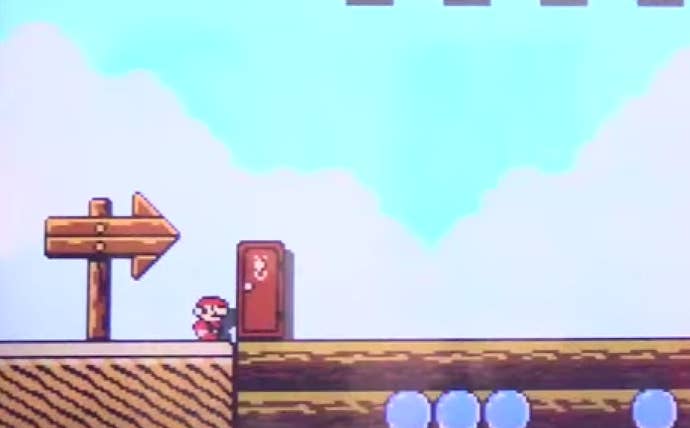Super Mario Bros. 2 Creator Kensuke Tanabe on Super Mario Maker's Missing Piece
Does the director of the oddball NES classic feel snubbed over his game's absence in Nintendo's upcoming game design tool?
This article first appeared on USgamer, a partner publication of VG247. Some content, such as this article, has been migrated to VG247 for posterity after USgamer's closure - but it has not been edited or further vetted by the VG247 team.
Super Mario Maker has evolved from the pleasant, simple foundation for designing Mario levels that Nintendo showcased at last year's E3 to a deliriously insane jumble of ideas that span the entirety of the series' history in two dimensions. Takashi Tezuka and his team have retrofit any number of latter-day Mario concepts into the style of games dating back 30 years, then empowered players to smash everything together into a sort of Mario fever dream.

And yet, there's one chapter of the Mario saga conspicuously missing from SMM's (almost) all-inclusive sandbox: 1988's Super Mario Bros. 2 for NES. And that's no small oversight; for a great many American Nintendo fans, SMB2 represents a sort of inflection point for their fandom. It was the Mario game that arrived right as the NES hit critical mass in the U.S., and it graced the cover of Nintendo Power issue 1, a magazine that showed up in millions of mailboxes around the country. As brilliant as Super Mario Maker looks, the fact that the only SMB2 element that appears to be in the game is the trademark red doors has been something of an elephant in the room for many fans.
As it happens, I had the opportunity to interview Nintendo's Kensuke Tanabe last week at E3. Tanabe was there to discuss Metroid Prime: Federation Force, but I did sneak in the question that had been on my mind all week: Where's Super Mario Bros. 2?
Tanabe laughed when I pointed to the Mario Maker poster on the wall of our interview room and asked about the apparent oversight. "Super Mario Bros. 2, as you know, when we created that game in Japan, it didn't have Mario as the main character," he said. Tanabe directed the original Japanese version of the game, a tie-in with a Fuji Television promotion that was reworked to become a Mario adventure when it came to the U.S. "Probably because of that, it's been overlooked for Super Mario Maker."
I asked if Tanabe had ever discussed the inclusion of his contribution to Mario canon with Super Mario Maker with producer Takashi Tezuka. "I didn't talk to Mr. Tezuka at all about it, actually," he admitted. "It does seem sort of unfortunate."
Still, Tanabe says there's still hope for the future, perhaps in the form of a SMB2-style version of Mario Maker. "If I ever have the chance, yes, it would be interesting to work on something like that," he said.
Of course, there's probably a more fundamental reason SMB2 didn't make the Mario Maker cut: It's a very different game from the rest. The original concept behind the level-creation project was to unify the mechanics of all Mario games, conferring uniform physics and skills across all titles included in the tool kit. There is, however, some uncertainty as to whether or not Tezuka's team has abandoned that plan for the final game.

Even so, while it would seem relatively straightforward to find a happy medium between the slightly slippery, inertia-heavy controls of the original Super Mario Bros. and the floaty wall-jumps of New Super Mario Bros., the unconventional mechanics of SMB2 would surely make for a massive headache as part of the Mario Maker sandbox. It featured a number of skills not seen in any other Mario adventure, including plucking, lifting, and heaving enemies and items; it's the one Mario title in which jumping on foes doesn't register as an attack, which represents a massive fundamental difference in play mechanics. Its rules would be completely incompatible with those of, say, Super Mario Bros. 3, which also included the ability to carry and throw objects, but in a completely different fashion from SMB2.
At the same time, SMB2 isn't some black sheep; Nintendo has happily incorporated it into Mario canon. The game was reissued in Japan as Super Mario Bros. USA, appeared in Super Mario All-Stars, and appeared as the launch title for the Game Boy Advance in all territories. Many of SMB2's enemies have become mainstays in Mario spin-offs (e.g. Shy Guys and Birdo) or even in the "core" Mario titles (e.g. Bob-ombs).
Tanabe himself still holds a certain fondness for the game and hopes for an opportunity to revisit it; perhaps as a direct follow-up to SMB2, or maybe in a completely different title. "I do still feel like the game mechanics — especially pulling things out of the ground — that's something I can still make another game out of," he mused. "It's just that I've been busy with all the other projects I'm working on.
"Even back [in the NES era], I was interested in creating another game in the style of Super Mario Bros. 2, but I never had the opportunity. But you never know. If you look at something like Federation Force, for example, it's something I had in mind for 10 years, but it's only now I've been able to realize the game idea!"
